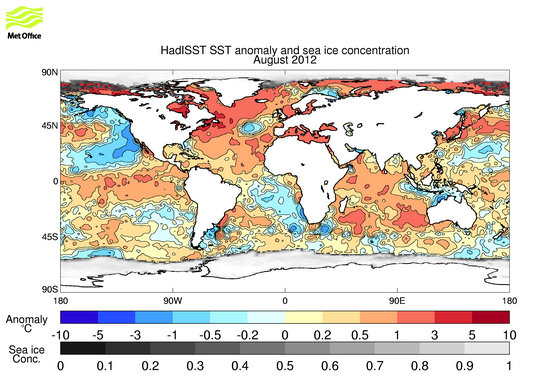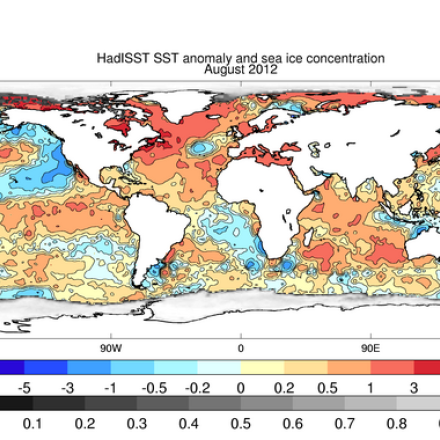SST data: HadiSST v1.1

Key Strengths
Key Limitations
Met Office, Hadley Centre. HadISST 1.1 - Global sea-Ice coverage and SST (1870-Present), [Internet]. NCAS British Atmospheric Data Centre, 2006, Date of citation,. Available from http://badc.nerc.ac.uk/view/badc.nerc.ac.uk__ATOM__dataent_hadisst
NCAR RDA: "The data for this study are from the Research Data Archive (RDA) which is maintained by the Computational and Information Systems Laboratory (CISL) at the National Center for Atmospheric Research (NCAR). NCAR is sponsored by the National Science Foundation (NSF). The original data are available from the RDA (http://rda.ucar.edu) in dataset number ds277.3."
Rayner, N. A.; Parker, D. E.; Horton, E. B.; Folland, C. K.; Alexander, L. V.; Rowell, D. P.; Kent, E. C.; Kaplan, A. (2003) Global analyses of sea surface temperature, sea ice, and night marine air temperature since the late nineteenth century, J. Geophys. Res., Vol. 108, No. D14, 4407 10.1029/2002JD002670
Cite this page
Acknowledgement of any material taken from or knowledge gained from this page is appreciated:
National Center for Atmospheric Research Staff (Eds). Last modified "The Climate Data Guide: SST data: HadiSST v1.1.” Retrieved from https://climatedataguide.ucar.edu/climate-data/sst-data-hadisst-v11 on 2025-12-17.
Citation of datasets is separate and should be done according to the data providers' instructions. If known to us, data citation instructions are given in the Data Access section, above.
Acknowledgement of the Climate Data Guide project is also appreciated:
Schneider, D. P., C. Deser, J. Fasullo, and K. E. Trenberth, 2013: Climate Data Guide Spurs Discovery and Understanding. Eos Trans. AGU, 94, 121–122, https://doi.org/10.1002/2013eo130001
Key Figures
Other Information
- Rayner, N.A., D.E. Parker, E.B. Horton, C.K. Folland, L.V. Alexander, D.P. Rowell, E.C. Kent, and A. Kaplan, 2003: Global analyses of sea surface temperature, sea ice, and night marine air temperature since the late nineteenth century. J. Geophys. Res. (A
- Deser, C., A. S. Phillips, and M. A. Alexander, 2010: Twentieth Century Tropical Sea Surface Temperature Trends Revisited. Geophys. Res. Lett., 37, L10701, doi:10.1029/2010GL043321
- Solomon, A and Newman, M, 2012: Reconciling disparate twentieth-century INdo_pacific icean temperature trends in the instrumental record, Nature Climate Change 2(9), 691-699. doi 10.1038/nclimate1591
- Chelton, D.B. and Risen, C.M., 2016: Zonal and Meridional Discontinuities and Other Issues with the HadISST1.1 Dataset (Technical report)
